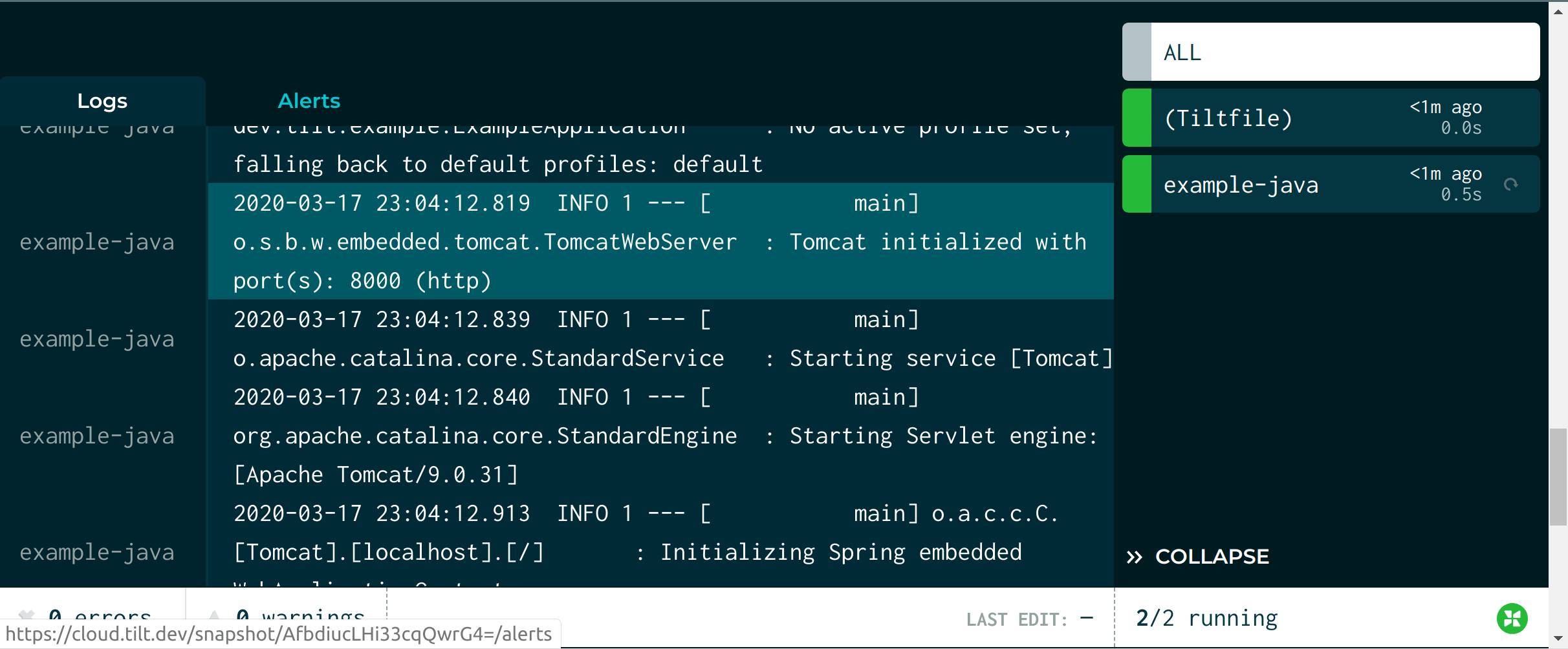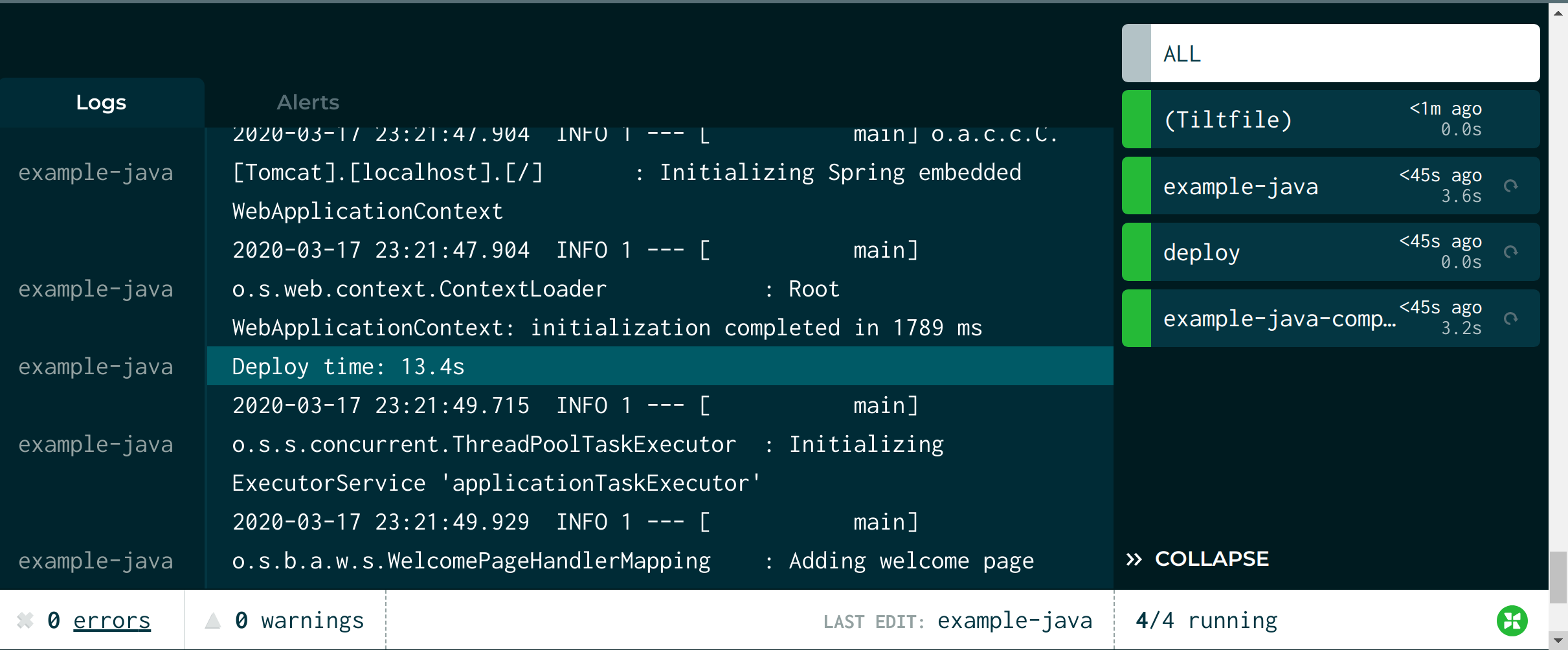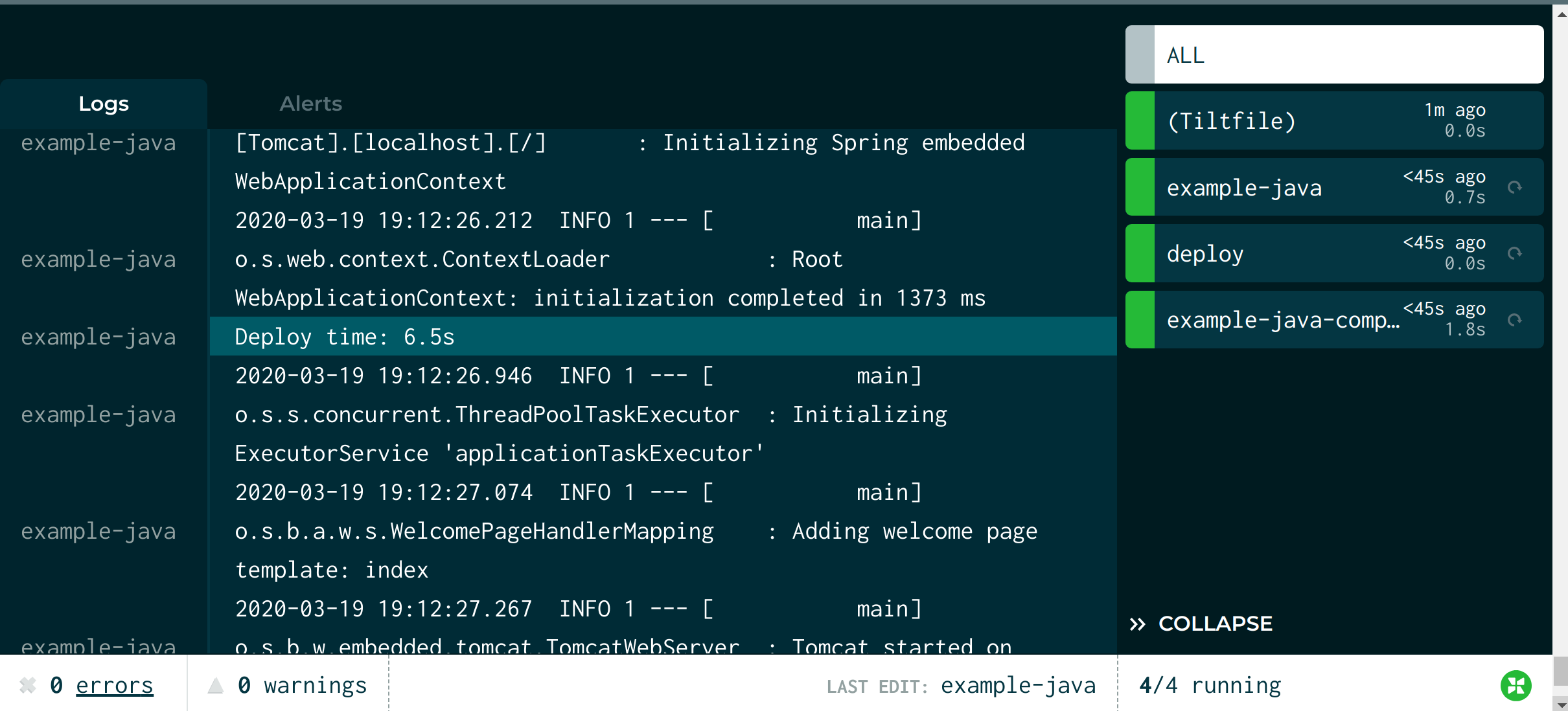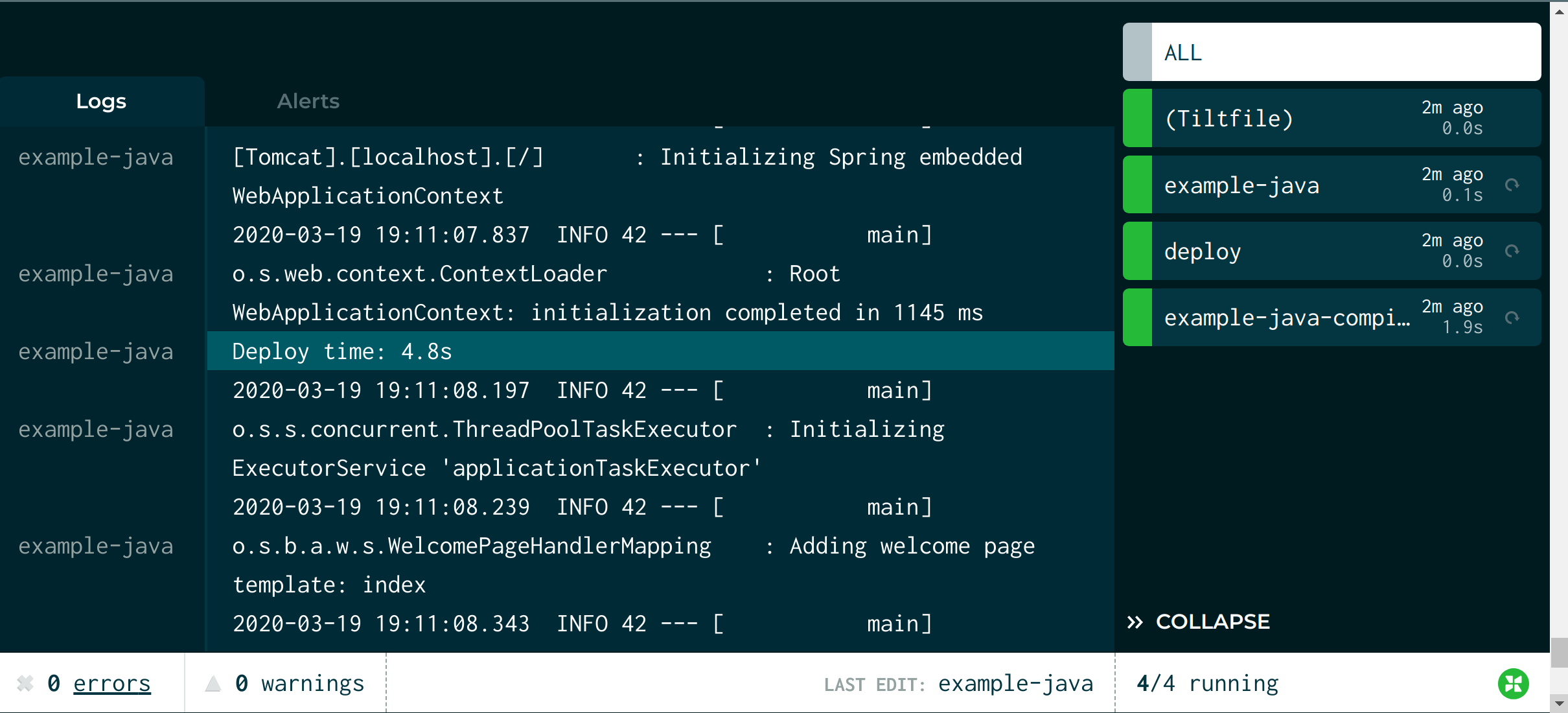Example: Java
The best indicator of a healthy development workflow is a short feedback loop.
Kubernetes is a huge wrench in the works.
Let’s fix this.
In this example, we’re going to take you through a simple server that uses Spring Boot and templates to serve HTML. Our example is loosely based on Serving Web Content with Spring MVC.
We’ll use Tilt to:
- Run the server on Kubernetes
- Measure the time from a code change to a new process
- Optimize that time for faster feedback
All the code is in this repo:
To skip straight to the fully optimized setup, go to this subdirectory:
Step 0: The Simplest Deployment
Our server uses Spring Web for routing requests.
package dev.tilt.example;
import org.springframework.stereotype.Controller;
import org.springframework.ui.Model;
import org.springframework.web.bind.annotation.GetMapping;
import org.springframework.web.bind.annotation.RequestParam;
@Controller
public class IndexController {
@GetMapping("/")
public String index(Model model) {
// Serves the index.html template under
// src/main/resources/templates/index.html
return "index";
}
}
To start this server on Kubernetes, we need three config files:
1) A Dockerfile that builds the image
2) A Kubernetes deployment that runs the image
3) And finally, a Tiltfile that ties them together:
docker_build('example-java-image', '.')
k8s_yaml('kubernetes.yaml')
k8s_resource('example-java', port_forwards=8000)
The first line tells Tilt to build an image with the name example-java-image
in the current directory.
The second line tells Tilt to load the Kubernetes
Deployment
YAML. The image name in the docker_build call must match the container image
reference in the example-java Deployment.
The last line configures port-forwarding so that your server is
reachable at localhost:8000. The resource name in the k8s_resource call
must match the Deployment’s metadata.name in kubernetes.yaml.
Try it! Run:
git clone https://github.com/tilt-dev/tilt-example-java
cd tilt-example-java/0-base
tilt up
Tilt will open a browser showing the web UI, a unified view that shows you app status and logs. Your terminal will also turn into a status box if you’d like to watch your server come up there.
When it’s ready, you will see the status icon turn green. The logs in the bottom pane will display “Tomcat initialized with port(s): 8000.”

Step 1: Let’s Add Benchmark Trickery
Before we try to make this faster, let’s measure it.
Using local_resource, you can direct Tilt to execute existing scripts or arbitrary shell commands on your own machine, and manage them from your sidebar like any other Tilt resource. We’re going to use this functionality to benchmark our deployments.
First, we add a local_resource to our
Tiltfile
that records the start time in a Java file.
k8s_resource(
'example-java',
port_forwards=8000,
resource_deps=['deploy'])
# Records the current time, then kicks off a server update.
# Normally, you would let Tilt do deploys automatically, but this
# shows you how to set up a custom workflow that measures it.
local_resource(
'deploy',
'./record-start-time.sh',
)
The local_resource() call creates a local resource named deploy. The second
argument is the script that it runs.
We’ve also modified our server to read that start time, calculate the time elapsed, then display this in both logs and HTML.
Let’s click the button on the deploy resource and see what happens!

| Approach | Deploy Time1 |
|---|---|
| Naive | 87.7s |
If you look closely, the elapsed time displayed in the Tilt sidebar is different than the benchmark our app logged. That’s OK! In microservice development, there are many benchmarks we care about – the time to build the image, the time to schedule the process, and the time until the server is ready to serve traffic.
Tilt offers you some default benchmarks, and the tools to capture your own.
Our benchmarks show this is slow. Can we do better?
Step 2: Let’s Optimize for the Java Toolchain
What’s taking up so much time? The logs show that when we make the change to a file, we:
1) Copy the source files to the image.
2) Download Gradle.
3) Download all the Spring dependencies.
4) Compile the Java jar from scratch.
But the Java community has done a lot of work to make caching dependencies and incremental compiles fast. How can we better use the tools how they’re meant to be used?
With local_resource, we can compile the executable Jar locally, and copy it
to the container.
Here’s our new Tiltfile with the following new code:
local_resource(
'example-java-compile',
'./gradlew bootJar',
deps=['src', 'build.gradle'],
resource_deps = ['deploy'])
docker_build(
'example-java-image',
'./build/libs',
dockerfile='./Dockerfile')
We’ve added a local_resource() that compiles the executable Jar locally
with Gradle.
We’ve adjusted the Docker context so that it only includes the build artifacts
under ./build/libs.
Finally, we’ve modified the Dockerfile to only copy the executable jar.
Let’s see what this looks like!

| Approach | Deploy Time |
|---|---|
| Naive | 87.7s |
| Local Compile | 13.4s |
Step 3: Why Is the Docker Build So Slow?
Currently, our image contains a fat executable Jar.
If we unpacked the fat Jar, we would find that the Jar contains many files internally. These files naturally lend themselves to Docker layers. Java Jars were using layer caches before Docker made them cool. How can we take advantage of this?
We’ve updated our
Tiltfile
to unpack the Jar in the build/jar directory:
local_resource(
'example-java-compile',
'./gradlew bootJar && ' +
'unzip -o build/libs/example-0.0.1-SNAPSHOT.jar -d build/jar',
deps=['src', 'build.gradle'],
resource_deps = ['deploy'])
We’ve also updated our Dockerfile:
FROM eclipse-temurin:17-jre-alpine
WORKDIR /app
ADD BOOT-INF/lib /app/lib
ADD META-INF /app/META-INF
ADD BOOT-INF/classes /app
ENTRYPOINT java -cp .:./lib/* dev.tilt.example.ExampleApplication
This Dockerfile adds files from build/jar in order from least frequently
used to most frequently used, to improve caching.
The Dockerfile also has a new the entrypoint to load the main application class, since we’re no longer using an executable Jar.
Let’s see what this looks like!

| Approach | Deploy Time |
|---|---|
| Naive | 87.7s |
| Local Compile | 13.4s |
| Optimized Dockerfile | 6.5s |
If you don’t want to optimize the Dockerfile yourself, check out Jib!
Jib is a Java image builder that re-packs Java Jars as container images using
similar tricks. There are Jib plugins for Maven and Gradle. The
tilt-example-java repo has
an example
Tiltfile
that uses custom_build to generate images with Jib.
Step 4: Let’s Live Update It
When we make a change to a file, we currently have to build an image, deploy new Kubernetes configs, and wait for Kubernetes to schedule the pod.
With Tilt, we can skip all of these steps, and instead
live_update the pod in place.
Here’s our new Tiltfile with the following new code:
load('ext://restart_process', 'docker_build_with_restart')
...
local_resource(
'example-java-compile',
gradlew + ' bootJar && ' +
'unzip -o build/libs/example-0.0.1-SNAPSHOT.jar -d build/jar-staging && ' +
'rsync --inplace --checksum -r build/jar-staging/ build/jar',
deps=['src', 'build.gradle'],
resource_deps = ['deploy'])
docker_build_with_restart(
'example-java-image',
'./build/jar',
entrypoint=['java', '-noverify', '-cp', '.:./lib/*', 'dev.tilt.example.ExampleApplication'],
dockerfile='./Dockerfile',
live_update=[
sync('./build/jar/BOOT-INF/lib', '/app/lib'),
sync('./build/jar/META-INF', '/app/META-INF'),
sync('./build/jar/BOOT-INF/classes', '/app'),
],
)
The first thing to notice is the live_update parameter, which consists of some sync steps.
They copy the library and compiled .class files from the ./build/jar
directory into the container.
After syncing the files, we want to restart our updated binary.
In this example, we restart the binary with the
restart_process extension,
which we imported with the load call on the first line.
We swap out our docker_build call for the docker_build_with_restart function we imported: it’s
almost exactly the same as docker_build, only it knows to restart our process at the end
of a live_update. The entrypoint parameter specifies what command to re-execute.
The restart_process extension is a lowest-common-denominator reload
tool. Tilt’s live_update API tries to be flexible enough so that you can use
native hot reload support if your framework supports it.
If you have more examples for specific frameworks, we’d be happy to add them to
the example repo.
Lastly, our local_resource first unzips the jar to build/jar-staging, and
then uses rsync --checksum to copy that to build/jar.
Tilt’s live_update will copy any files that have been touched.
rsync --checksum copies the directory, but doesn’t touch any files that haven’t changed.
Let’s see what this new configuration looks like in action:

Tilt was able to update the container in less than 5 seconds!
Our Recommendation
Final Score
| Approach | Deploy Time |
|---|---|
| Naive | 87.7s |
| Local Compile | 13.4s |
| Optimized Dockerfile | 6.5s |
| With live_update | 4.8s |
You can try the server here:
Congratulations on finishing this guide!
Further Reading
CI
Once you’re done configuring your project, set up a CI test to ensure
your setup doesn’t break! In the example repo, CircleCI uses
ctlptl to create a single-use Kubernetes
cluster. The test script invokes tilt ci. The tilt ci command deploys all
services in a Tiltfile and exits successfully if they’re healthy.
Optimizations
This guide recommends an approach to Java development that shines with Tilt.
There are even more optimizations you can add. Many are toolchain-specific. We’ve heard that you can get the JVM to hot-reload class files (e.g. with Spring Loaded) but we’ve had mixed results using this with live_update.
For more discussion of build optimization, see:
- Spring Boot Docker, a discussion of how to better optimize Spring Boot apps for Docker. We used many of the lessons in this guide. There are still more tricks for improving performance in containers.
- Tilt’s Java Examples repo, which besides the code
from this guide, contains examples of how to use Tilt with a number of different Java tools, including:
- Jib, a Java image builder that re-packs Java Jars as container images, and integrates well with existing Maven or Gradle builds (example here).
- Quarkus, a container-first, hot-reloading framework for writing Java applications (example here).
Examples in other languages:
-
Tilt’s first deployment of a service takes a few seconds longer than subsequent ones, due to some behind-the-scenes setup. Measurements in this guide focus on non-initial builds. ↩